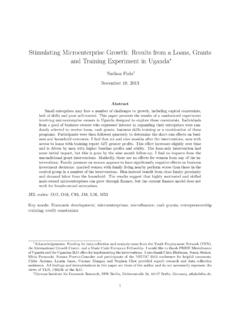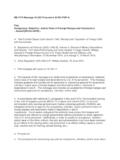Transcription of Currency Devaluation and Economic Growth The …
1 Currency Devaluation and Economic Growth The case of ethiopia Tirsit Genye September 30, 2011 EC9901 Master Thesis, 30hp Department of Economics Stockholm University Supervisor: Lennart Erixon Currency Devaluation and Economic Growth The case of ethiopia Abstract Devaluation of Currency has an ambiguous effect on Economic Growth of a country.
2 In this paper I analyze the effects of Devaluation on GDP per capita Growth in ethiopia using time series data from 1980 to 2010. Beside the exchange rate I use variables such as education, private investment, openness to determine Ethiopian GDP per capita Growth . The study showed that Devaluation has a negative effect on GDP per capita the same year whereas the coefficient for the one year lagged exchange-rate was significantly positive thus Devaluation has a time varying effect. Education had an expansionary effect and drought a contractionray effect on GDP per capita Growth .. Table of Contents 1.
3 Introduction .. 4 2. Growth and Devaluation in ethiopia .. 5 Economic Growth in ethiopia .. 5 Devaluation of Ethiopian Birr .. 7 3. Theoretical literature review .. 8 Pros of devaluations .. 8 Cons of Devaluation .. 9 Summarizing the theoretical literature .. 11 4. Empirical Literature Review of Developing Countries .. 12 5. The empirical study .. 14 The Regression model .. 14 Definition and measures .. 16 Regression Techniques .. 16 Time period and Data Sources .. 17 Regression Analysis and Results .. 17 6. Comparison with other studies .. 21 7. Conclusions .. 23 References .. 24 1.
4 Introduction Today, in many countries, especially the developing ones, the weakening of their Currency the decrease or depreciation of their own Currency in terms of foreign currencies has become a central Growth issue. These Currency changes can have an expansionary or contractionary effect on Economic Growth . Many development organizations like International Monetary Fund (IMF) support the idea of Devaluation of Currency as one means of Economic Growth besides the financial aid and loans to their member countries for the development of domestic firms. It will increase competitiveness of firms and increase the production of domestic products and output.
5 However, some researchers focusing on developing countries (Krugman & Taylor, 1978) shed light on the negative effect of Devaluation on output. Despite ambiguous results from empirical studies Devaluation of Currency has been used as a Growth strategy by many developing countries. ethiopia , which is one of the sub-Saharan countries, is listed as the least developed countries in the world. Many factors explain the weak Economic development of the country. Policies like building up institutions, privatization of the public sector and Devaluation of the Currency were used in the last twenty years in order to create a sustainable Economic development.
6 The purpose of the paper is to analyze whether devaluations in ethiopia have had a positive or negative effect on GDP per capita Growth . For that purpose I have made a time series analysis of ethiopia based on data from 1980 to 2010. My multiple regression study also considers the effects of factors other than devaluations and it also tries to distinguish the mechanisms behind a relationship between devaluations and GDP per capita Growth . Even though the study focuses on ethiopia , the results from my study can hopefully be used when evaluating the Growth effects of Currency devaluations in other developing countries.
7 The remaining section of the paper is as follows: Section 2 will describe the Growth performance and Devaluation strategy of ethiopia . Section 3 and 4 provides a review of the previous theoretical and empirical literature respectively. Section 5 presents analysis and interpretation of the study. Section 6 compares my results with those from previous studies. Some concluding remarks will be made in the final section. 2. Growth and Devaluation in ethiopia Economic Growth in ethiopia Economic Growth of the country has shown various changes in different political regimes. These change in government structure created a problem of inconsistency in implementing the policies by previous regimes as well as natural disaster like famine and drought had a depressing effect on the history of Economic Growth of the country.
8 Thus in my study I have tried to compare the present and the last two regimes. During the Imperial Regime (1930- 1974), the county had an experience for modern technology , developments in infrastructure and industries that showed an increase in the rate of GDP in the late 1960 and beginning of 1970 s compared to the previous periods. But during the last years of the Imperial regime the GDP Growth rate started to fall mainly due to famine in some parts of the country. In addition the rise of opposition parties and political disorder in the country had enormous role for the decrease in GDP (Geda & Befekadu, 2005) Under the Derg regime (1975- 1991), known for its socialist policy, ethiopia s GDP Growth became lower.
9 These was related to the takeover of the private sector by the government, high pressure from different opposition parties within the country as well as war with Somalia within the first three years were some of the major effects behind the fall in output Growth in the country during the Derg Regime. The severe drought that took place in 1984/85 was also additional factor for the decrease in total GDP.(Ibid) In 1984 and 1985 the severe drought declined the Growth rate by 3% and 10% in per capita respectively. The figure below shows the annual change GDP per capita Growth .
10 Source:-World Bank (2010) GDP per capita (% annual) in ethiopia from 1982 to 2009 From the graph we can see that in 1983, 1986 and 1987 there was an increase in the GDP per capita compared to the other years. After the fall of the Derg regime, a Transitional Government of ethiopia (TGE) led by the Ethiopian People's Revolutionary Democratic Front (EPRDF) (1991- Present) took power. In this regime new polices where some of the private sector can involve in the market was set even though some of the services like telecommunications, electricity.







